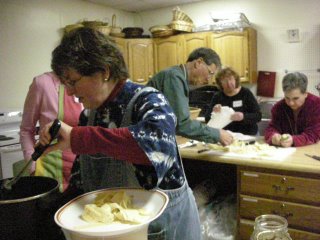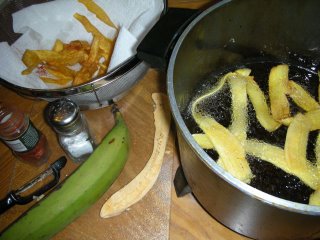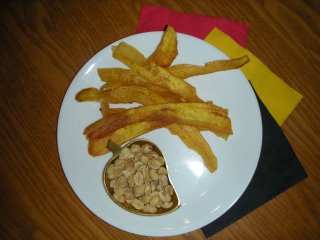Recipe #1: Green Plantain Chips
 I hope you read yesterday's post about my new challenge to myself. I calculate that if I put up a recipe (at least a draft) every day, taking Saturday and Sunday off, for the rest of the year, that will be 171 recipes. That should cover most of the book. I'll begin with a very popular item throughout Sub-Saharan Africa: green plantain chips. I make these frequently--twice in the last week: once with a cooking class on "The meaning of food" (see the photo on the right) and once for the local Chamber of Business and Industry "Spotlight" for members. Both times we had them with bissap, a hibiscus iced tea, but that recipe is for another day.
I hope you read yesterday's post about my new challenge to myself. I calculate that if I put up a recipe (at least a draft) every day, taking Saturday and Sunday off, for the rest of the year, that will be 171 recipes. That should cover most of the book. I'll begin with a very popular item throughout Sub-Saharan Africa: green plantain chips. I make these frequently--twice in the last week: once with a cooking class on "The meaning of food" (see the photo on the right) and once for the local Chamber of Business and Industry "Spotlight" for members. Both times we had them with bissap, a hibiscus iced tea, but that recipe is for another day. BTW, green plantain chips are a great way to impress your friends if you're from Pennsylvania where they're exotic (but not so if you're from, say, Florida), they're cheap and easy to make, and I never have any left over! Our local African Market owner says they're the one sure seller in her store, too. Freshly made chips have it over those packaged ones in the stores any day.
Start with big green plantains. Since they sell them by the "each" in our stores here, I always buy the biggest, greenest ones I can get, but that's not necessarily the most flavorful. Most people won't know the difference. If you plan to use a vegetable peeler to make them into strips, it's a good idea to try and find plantains that are fairly flat as opposed to really curved.
Here's the basic recipe:
Ingredients
1. 2 or 3 large plantains will make enough for several people for a snack
2. vegetable oil for deep frying (I usually use canola)
3. salt to taste
Equipment:
1. a sharp knife a sturdy vegetable peeler (I'm partial to my Farberware one) or mandolin or grater
2. a strainer basket or colander lined with paper towels for draining
3. a heavy deep pan for frying (I use a deep fryer or my large cast iron skillet)
4. cutting board (optional)
5. a long-handled slotted spoon
Directions:
Rinse the plantain and peel it by slicing off each end, then make a long slit along the length without cutting into the plantain itself. Make a cut around the circumference of the center of the plantain peel, also avoiding the actual plantain. This allows you to remove the peeling in pieces.
Use the tip of the knife to pry the peeling loose to get started. Scrape off any fibrous strings on the plantain with the knife.
There are different ways to slice the plantain: some like to cut them into thin circles or ovals on a cutting board. I prefer to make elegant long slices using a potato peeler (or you could use a grater or mandolin). These are easy to make very thin and crisp. Fill the pan or deep fryer not more than half full, then heat the oil to about 365 degrees Farenheit (185 degrees Centigrade). [If I'm using my stove top, the medium high setting will give me approximately the correct temperature, but I do have to turn it up and down to keep it from getting too hot. If you drop a piece of plantain into the oil and it sits on the bottom, the oil is too cold. If as soon as you drop it in it comes to the top and almost immediately begins to brown, the oil is too hot.]
You can either make a bunch of slices and then drop them one by one, or drop them in as you slice each one. I usually get about 1 1/2 dozen slices ready and then put them in. Don't add them all at once or they'll clump. I usually keep nudging them as I put them in to keep them from sticking to each other. Stir with a long-handled spoon to make sure they cook evenly. After a few minutes, remove the chips when they are golden and drain them on a lined colander. If the chips "bend" they're not fully cooked: they should be crispy, like potato chips.
Salt the chips while they are still warm. After they cool, store them in an airtight container.
Hints: I often just lie a plantain on a cutting board and run the peeler along it a few times, turn the plantain over and do the same thing, then turn the plantain a quarter turn to do it again (and finally rotate it one more time, then repeat as necessary. This keeps the slices nice and even and it works for me. If it's too complicated for you, do whatever is easiest. Also, if you don't want to fuss with long slices (or they won't fit in your fryer/pan), just cut the plantains in half and make shorter slices.
Variation: if you prefer spicy, sprinkle the chips with salt AND ground red pepper to taste.
Chips go well with any cold drink, from beer to iced tea.
Here's a not-so-great plantain I have in the kitchen right now. At least it will give you the idea.


Labels: Ghana cookbook, plantain chips


1 Comments:
i think one recipe per day is too aggressive. give us time to read the posts and try the recipes if/when we have time... and i agree with the comment from your previous post- explaining the recipes is KEY... and any photos you can dig up from Ghana that show the context would be helpful too...
Post a Comment
<< Home